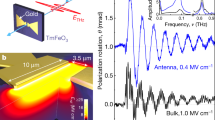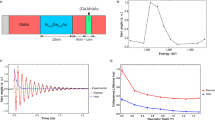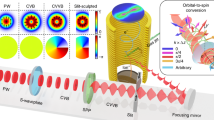Abstract
The spin–orbit interaction (SOI) in zincblende semiconductor quantum wells can be set to a symmetry point, in which spin decay is strongly suppressed for a helical spin mode. Signatures of such a persistent spin helix (PSH) have been probed using the transient spin-grating technique, but it has not yet been possible to observe the formation and the helical nature of a PSH. Here we directly map the diffusive evolution of a local spin excitation into a helical spin mode by a time-resolved and spatially resolved magneto-optical Kerr rotation technique. Depending on its in-plane direction, an external magnetic field interacts differently with the spin mode and either highlights its helical nature or destroys the SU(2) symmetry of the SOI and thus decreases the spin lifetime. All relevant SOI parameters are experimentally determined and confirmed with a numerical simulation of spin diffusion in the presence of SOI.
This is a preview of subscription content, access via your institution
Access options
Subscribe to this journal
Receive 12 print issues and online access
$209.00 per year
only $17.42 per issue
Buy this article
- Purchase on Springer Link
- Instant access to full article PDF
Prices may be subject to local taxes which are calculated during checkout






Similar content being viewed by others
References
Winkler, R. Spin-Orbit Coupling Effects in Two-Dimensional Electron and Hole Systems (Springer, 2003).
Dyakonov, M. I. (ed.) in Spin Physics in Semiconductors (Springer, 2008).
König, M. et al. Quantum spin Hall insulator state in HgTe quantum wells. Science 318, 766–770 (2007).
Sau, J. D., Lutchyn, R. M., Tewari, S. & Das Sarma, S. Generic new platform for topological quantum computation using semiconductor heterostructures. Phys. Rev. Lett. 104, 040502 (2010).
Mourik, V. et al. Signatures of Majorana fermions in hybrid superconductor- semiconductor nanowire devices. Science 336, 1003–1007 (2012).
Koralek, J. D. et al. Emergence of the persistent spin helix in semiconductor quantum wells. Nature 458, 610–613 (2009).
Nitta, J., Akazaki, T., Takayanagi, H. & Enoki, T. Gate control of spin-orbit interaction in an inverted In0.53Ga0.47As/In0.52Al0.48As heterostructure. Phys. Rev. Lett. 78, 1335–1338 (1997).
Studer, M., Salis, G., Ensslin, K., Driscoll, D. C. & Gossard, A. C. Gate-controlled spin-orbit interaction in a parabolic GaAs/AlGaAs quantum well. Phys. Rev. Lett. 103, 027201 (2009).
D’yakonov, M. I. & Perel’, V. I. Spin relaxation of conduction electrons in noncentrosymmetric semiconductors. Sov. Phys. Solid State 13, 3023–3026 (1972).
Schliemann, J., Egues, J. C. & Loss, D. Nonballistic spin-field-effect transistor. Phys. Rev. Lett. 90, 146801 (2003).
Bernevig, B. A., Orenstein, J. & Zhang, S-C. Exact SU(2) symmetry and persistent spin helix in a spin-orbit coupled system. Phys. Rev. Lett. 97, 236601 (2006).
Wunderlich, J. et al. Spin Hall effect transistor. Science 330, 1801–1804 (2010).
Duckheim, M. & Loss, D. Resonant spin polarization and spin current in a two-dimensional electron gas. Phys. Rev. B 75, 201305(R) (2007).
D’Amico, I. & Vignale, G. Theory of spin Coulomb drag in spin-polarized transport. Phys. Rev. B 62, 4853–4857 (2000).
Yang, L. et al. Doppler velocimetry of spin propagation in a two-dimensional electron gas. Nature Phys. 8, 153–157 (2012).
Yang, L., Orenstein, J. & Lee, D-H. Random walk approach to spin dynamics in a two-dimensional electron gas with spin–orbit coupling. Phys. Rev. B 82, 155324 (2010).
Stephens, J. et al. Spin accumulation in forward-biased MnAs/GaAs Schottky diodes. Phys. Rev. Lett. 93, 097602 (2004).
Crooker, S. A. & Smith, D. L. Imaging spin flows in semiconductors subject to electric, magnetic, and strain fields. Phys. Rev. Lett. 94, 236601 (2005).
Meier, L. et al. Measurement of Rashba and Dresselhaus spin-orbit magnetic fields. Nature Phys. 3, 650–654 (2007).
Ryan, J. F. et al. Time-resolved photoluminescence of two-dimensional hot carriers in GaAs–AlGaAs heterostructures. Phys. Rev. Lett. 53, 1841–1844 (1984).
Acknowledgements
We would like to acknowledge financial support from the Swiss National Science Foundation through NCCR Nano and NCCR QSIT, as well as valuable discussions with R. Allenspach, K. Ensslin and Y. Chen.
Author information
Authors and Affiliations
Contributions
M.P.W. and G.S. designed the experiment, interpreted the data and wrote the manuscript. M.P.W. performed the time-resolved experiment. C.R. and W.W. grew the samples. G.S. performed numerical simulations.
Corresponding author
Ethics declarations
Competing interests
The authors declare no competing financial interests.
Supplementary information
Supplementary Information
Supplementary Information (PDF 319 kb)
Rights and permissions
About this article
Cite this article
Walser, M., Reichl, C., Wegscheider, W. et al. Direct mapping of the formation of a persistent spin helix. Nature Phys 8, 757–762 (2012). https://doi.org/10.1038/nphys2383
Received:
Accepted:
Published:
Issue Date:
DOI: https://doi.org/10.1038/nphys2383
This article is cited by
-
Spin-texture topology in curved circuits driven by spin-orbit interactions
Communications Physics (2023)
-
Room-temperature electrically switchable spin–valley coupling in a van der Waals ferroelectric halide perovskite with persistent spin helix
Nature Photonics (2022)
-
Flying electron spin control gates
Nature Communications (2022)
-
Interplay of spin–orbit coupling and Coulomb interaction in ZnO-based electron system
Nature Communications (2021)
-
Rashba-like spin splitting along three momentum directions in trigonal layered PtBi2
Nature Communications (2019)



